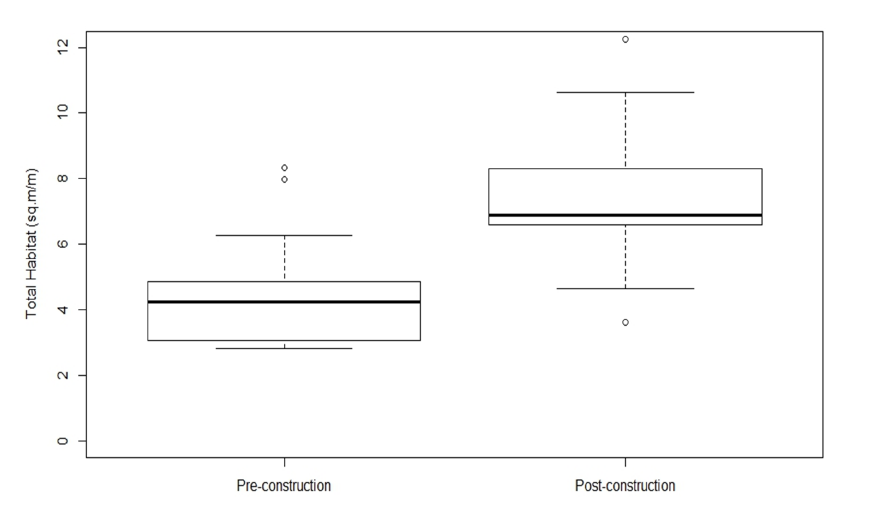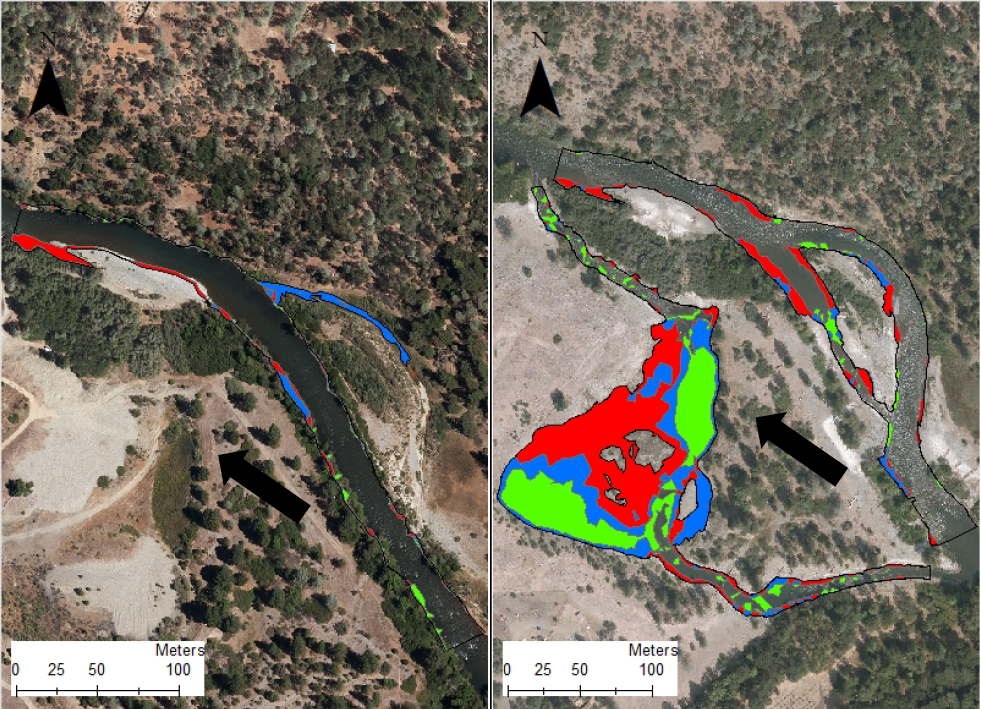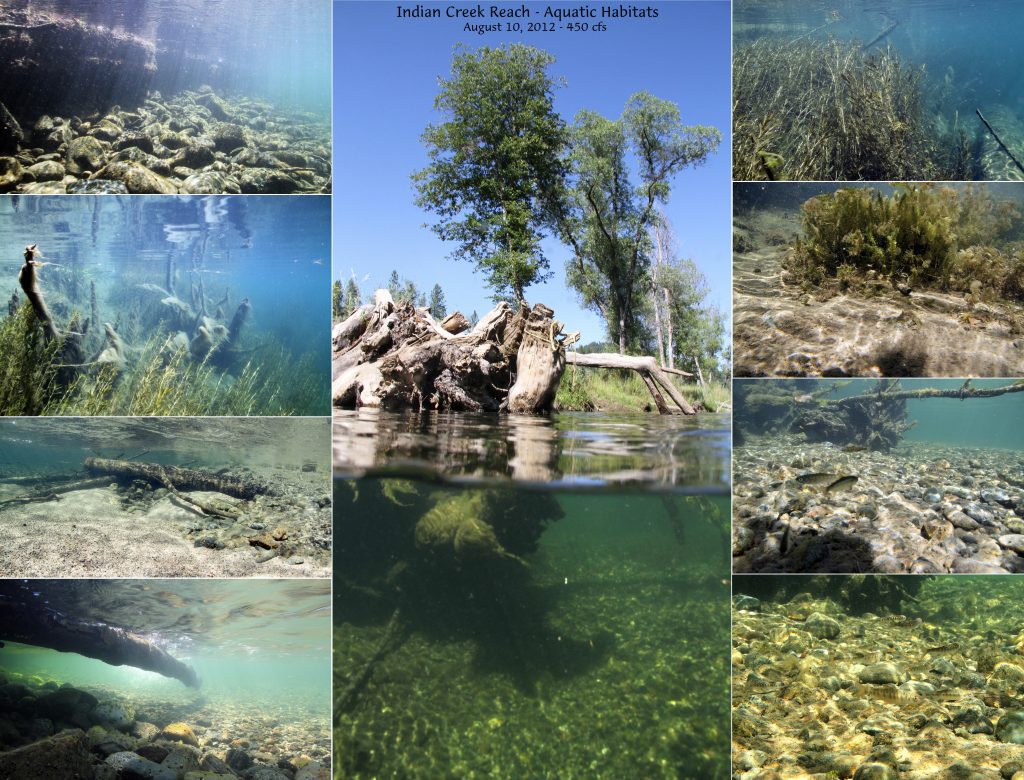JUVENILE SALMONID REARING HABITAT
A primary goal of the Program is to increase fish habitat quality and quantity to support increased salmonid populations. Changes in rearing habitat availability for salmonids were assessed over the 40 miles of the Trinity River and pre- and post-construction at channel rehabilitation sites.
Salmonid Habitat
Anadromous adult salmonids enter the river from the ocean and hold until they are ready to spawn. Some species, such as spring-run chinook and summer steelhead, enter the river months prior to spawning; these fish hold in deep pools for protection from predators and for cool thermal refuge during the summer. Once spawning begins, salmonids construct redds (spawning areas) in gravel. Adult salmonids select a spawning site with appropriate gravel size, water velocities, and depth. The size of the gravel selected by the fish is typically related to the size of the fish constructing the redd. Adult salmonids deposit eggs into the redd where they incubate in the spaces between gravel particles. Clean spawning gravels are important because fine sediment accumulation in the redd can affect the oxygen supply to the eggs, thereby decreasing survival and (or) emergence success. Conversely, good subgravel flows provide high levels of dissolved oxygen, resulting in increased egg survival to hatching. Incubation time for eggs and egg survival rates are dependent on water temperature, with warmer water supporting faster hatching times. Redd scour, often associated with flooding, can increase egg mortality, but scour is necessary to maintain clean, high-quality spawning gravels.
REARING HABITAT IN RESTORATION REACH
Habitat assessments are conducted at bank rehabilitation sites and at randomized river segments (GRTS design) by mapping the boundaries of the habitat using the numeric criteria for water depth, velocity and presence of cover or substrate.
Juvenile Salmonid Habitat Increases
Greater than 50% increase in juvenile salmonid habitat at 92% of channel rehabilitation sites surveyed.

Restoration efforts have increased juvenile Chinook rearing habitat by over 50% at 13 sampled sites within the restoration reach from 2005-2015. From Boyce et al. (2018).
In 2010 rearing habitat availability was mapped at 32 randomly selected sites and these sites were revisited in 2015. The sample included TRRP channel rehabilitation sites surveyed in 2010 and 2015 both before and after construction, sites surveyed only after construction prior to 2010, and sites with no channel rehabilitation actions. All sites with channel rehabilitation actions completed since the 2010 survey showed improvements in habitat availability, demonstrating the benefits of channel rehabilitation. Rearing habitat area increased at only two of the seven sites constructed before 2010, while it increased at 12 of the 18 sites with no channel rehabilitation actions.
GRTS Sampling Estimates
Generalized Random Tesselation Stratified (GRTS) is a useful approach to drawing spatial samples. GRTS is a form of spatially-balanced sampling that is a true probability design that is used to monitor aquatic resource characteristics.
REARING HABITAT IN CHANNEL REHABILITATION SITES
In order to validate fish use of the mapped rearing habitat, snorkeling has been used to count fish inside and outside of the mapped habitat areas. Chinook juvenile counts inside designated rearing habitats averaged at least 30 fish per site, whereas counts outside of rearing habitat designations averaged less than five fish per site.
Bucktail Channel Rehabilitation Site – 2016
The Bucktail channel rehabilitation site was constructed in 2009 and enhanced in 2016. Juvenile Chinook and coho salmon rearing habitat was surveyed in 2008, 2009, and 2015 and 2017. Overall, salmon-rearing habitat increased across all criteria with the addition of a side channel and pond at the 2016 project (see image below).

Aerial view of the Bucktail rehabilitation site pre-construction in 2015 (left) and post-construction 2017 (right) with habitat areas mapped at approximate flows of 700 cfs. Blues areas indicate optimal presmolt habitat, red and green areas indicate suitable presmolt habitat (HVTF, USFWS, YTFP, 2017).
Lower Junction Channel Rehabilitation Site – 2014
The Lower Junction City channel rehabilitation site was completed in 2014. Salmon-rearing habitat was evaluated before construction between 2011 and 2013 and after construction in 2015, surveys were conducted during summer base flow. Total presmolt rearing habitat increased by 51% (Martin, 2016).

